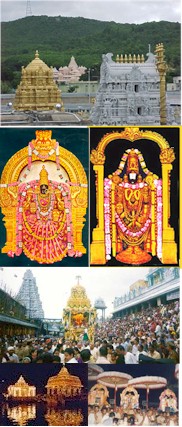Welcome to Adiyen Sri Ramanuja Dasan !
" Srimathe Ramanujaya Namaha !"
Sri Ramanujacharya! SreemathE ramanujaya namah.!
By this time, Ramanuja's fame had spread far and wide. He became a good controversialist. Then he wrote his commentary on the Brahma Sutras known as the Sri Bhashya. The Visishtadvaita system is an ancient one. It was expounded by Bodhayana in his Vritti, written about 400 B.C. It is the same as that expounded by Ramanuja; and Ramanuja followed Bodhayana in his interpretations of the Brahma Sutras. Ramanuja's sect of Vaishnavas is called by the name Sri Sampradaya. Ramanuja wrote also three other books--Vedanta Sara (essence of Vedanta), Vedanta Sangraha (a resume of Vedanta) and Vedanta Deepa (the light of Vedanta).
Ramanuja travelled throughout the length and breadth of India to disseminate the path of devotion. He visited all the sacred places throughout India including Kashi, Kashmir and Badrinath. On his way back he visited the Tirupathi hills. There he found the Saivites and the Vaishnavites quarrelling with one another, one party contending that the image of the Lord in the Tirupathi hills was a Saivite one and the other party saying that it was a Vaishnavite one. Ramanuja proposed that they should leave it to the Lord Himself to decide the dispute. So they left the emblems of both Siva and Vishnu at the feet of the Lord, and after locking the door of the temple, both parties stayed outside on guard. In the morning, when they opened the doors, it was found that the image of the Lord was wearing the emblems of Vishnu, while the emblems of Siva were lying at its feet as left there the evening before. This decided that the temple was a Vaishnavite one and it has remained so ever since.
Ramanuja then visited all the Vaishnavite shrines in South India and finally reached Srirangam. Here he settled himself permanently and continued his labours of preaching the Visishtadvaita philosophy and writing books. Thousands of people flocked to him everyday to hear his lectures. He cleansed the temples, settled the rituals to be observed in them, and rectified many social evils which had crept into the community. He had a congregation of 700 Sannyasins, 74 dignitaries who held special offices of ministry, and thousands of holy men and women, who revered him as God. He converted lakhs of people to the path of Bhakti. He gave initiation even to washermen. He was now seventy years old, but was destined to live many more years, establish more Mutts, construct more temples and convert many more thousands of people.
The Chola king about this time was Kulothunga I and he was a staunch Saivite. He ordered Ramanuja to subscribe to his faith in Siva and acknowledge Siva as the Supreme Lord.
Two of the disciples of Ramanuja, Kuresa and Mahapurna, donned the orange robes of Sannyasins and visited the court of Kulothunga I in place of Ramanuja. They argued there for the superiority of Vishnu. The monarch refused to hear them and had their eyes put out.
The two unfortunate people started for Srirangam--their native place. Mahapurna was a very old man, and unable to bear the pain, died on the way. Kuresa alone returned to Srirangam.
Meanwhile, Ramanuja, with a few followers, by rapid marches through day and night, reached the foot-hills of the Western Ghats, about forty miles west of Mysore. There, after great difficulties, he established himself and spent some years in preaching and converting people to the Visishtadvaita philosophy.
Jai Srimannaryana !
Thanks for your valuable time. Visit our web site again for more information and latest updates.

